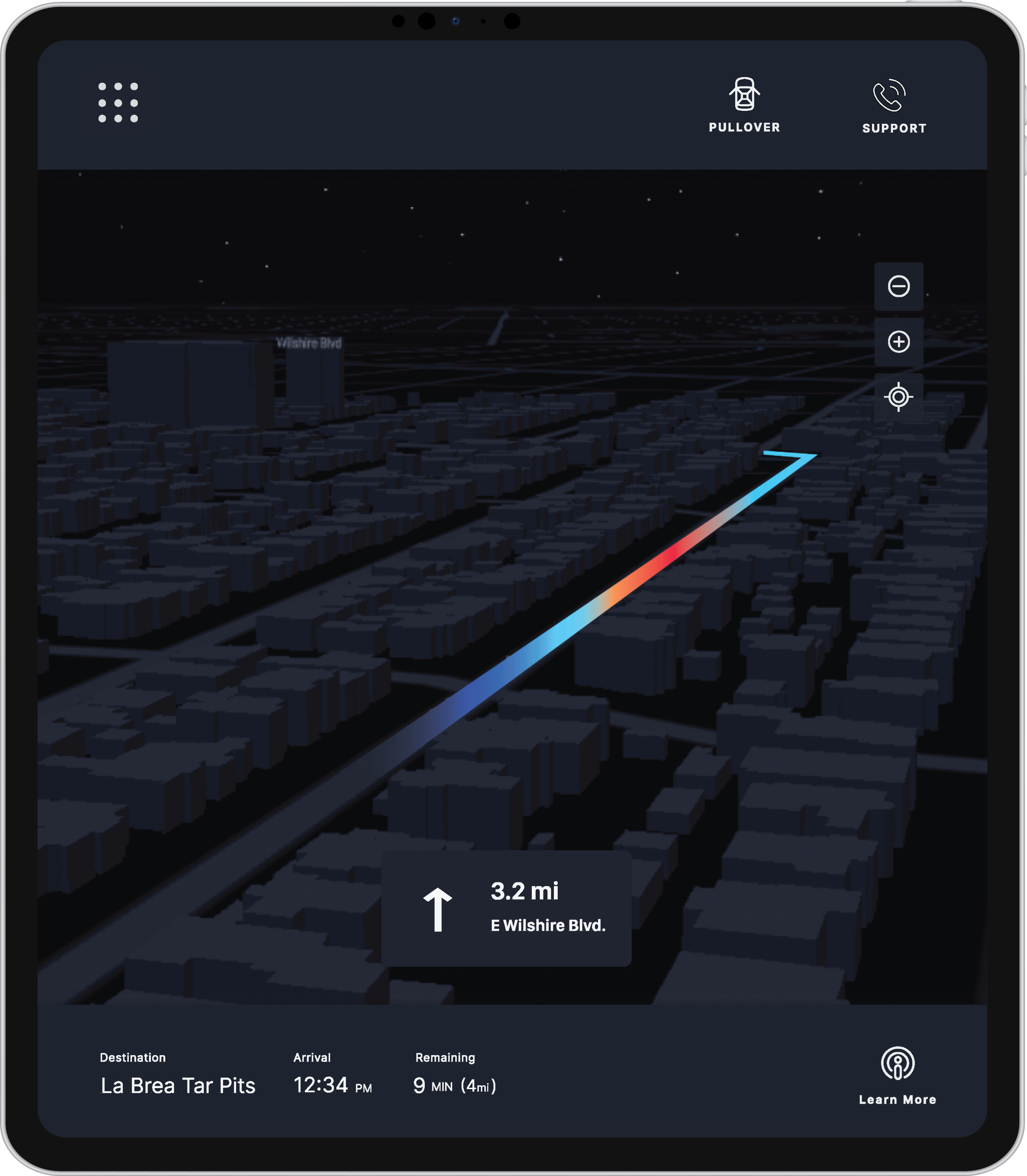

This case study required investigative research on the current AV industry environment and ideating new experience design features for AV rideshare products.
The aspect of this project that I found particularly fascinating was exploring new innovative ways of creating a seamless autonomous customer journey that facilitates brand trust. All of this, in an environment with little previous customer experience as well.
When it comes to Autonomous Vehicles UX design there are so many questions yet to be answered. My project seeks to answer some of these AV specific UX challenges, like:
This interface project utilizes a level 4, "High Automation" for AV tech.
The ride share service that I designed has no in vehicle attendant, but would be assigned to a remote vehicle attendant ready to jump in if some aspect of the AV machine learning had not encountered a situation and needed someone to map a manual way points for the ride.
In order to differentiate this interface, I wanted to offer a product that provided a more immersive experience. The resulting design seeks to tackle the challenge of gaining the rider’s emotional trust and creating a meaningful connection to the product.
This unanticipated direction emerged after completing the initial research phase. The project became less about the logistics of the interface and functionality, as I initially thought, and more about the creation of an immersive rideshare experience to connect the user emotionally to the product. This modified the questions I needed to ask in the next research stage to better understand the potential customer and create a product to accomplish my goals.
Autonomous Vehicles have been formally on the minds of the auto industries leaders since the early 1930’s. In fact, the concept of the autonomous car dates back to a General Motors exhibit, “Futurama,” presented at the 1939 New York World’s Fair.
Many engineers over the years have labored to make the dream of autonomous vehicles a reality. In 1969, John McCarthy, widely celebrated as one of the founding fathers of artificial intelligence penned the essay titled, “Computer-Controlled Cars,” envisioning today’s autonomous vehicle future well ahead of its time.
However, it wasn’t really until ground breaking car companies introduced parking assistance in the early 2000’s that commercial autonomous vehicles started to seem like a plausible reality.
Then in 2009 when news hit of Google’s secretly launched Self-Driving project Waymo, in only a few short years the company announced its prototypes had collectively driven 300,000 miles under computer control without a single accident, an impressive feat that caught many off-guard.
In 2014, Google revealed an autonomous prototype without a steering wheel, a gas pedal, or a brake pedal and it was 100% autonomous. All sure fire sign technology is almost in place for AV technology to be widely utilized as a new alternative to human operated driving.
However, it turns out that the adoption of Autonomous Vehicle technology is not just about the technological ability itself. There are also far more complex implications to consider when exploring the hidden aspects of the human psyche that need to be convinced in order for the AV market to finally be adopted by the average car consumer in society.
And this technology seems to be advancing faster than the consumer’s desire to fully adopt autonomous vehicle tech. For example, even when the data proved self-parking technology outperformed unassisted drivers in four key areas, a 2015 AAA survey found that only one in four drivers would trust self-parking technology, and 80 percent were more confident in their own parallel parking skills.
It seems only natural for people to be resistant to such a large lifestyle change like the one provided by autonomous vehicle tech making human operated driving optional. However, looking at the predicted safety stats, AV tech will solve most of the accidents on the road every year in the U.S. and save countless lives once widely adopted, so it's definitely a leap we should all be willing to take.
From my research, I learned that to understand the full potential of autonomous vehicle safety features, time will only provide the hard stats, but researchers are intelligently predicting the results to be quite impressive. For example the AV industry’s Advanced Driver Assistance Systems (ADAS) alone could save a majority of the vehicle related deaths each year.
According to the World Health Organization (WHO) car accidents are annually responsible for approximately 1.3 million deaths worldwide. In the U.S. alone, ADAS technologies have the potential to prevent 26,607 deaths per year, or about 62% of total traffic deaths. This means of the 42,915 people who lost their lives in 2021 because of motor vehicle crashes, 26,607 deaths could have been completely prevented if autonomous vehicle safety technology was integrated in the vehicles involved. Not only that, but throw in $150.04 billion dollars saved of the estimated $242 billion the U.S. economy spends on car crash related expenditures each year.
The more research that is done, the more readily it becomes apparent that the greatest challenge in the AV consumer industry isn’t the technology itself. The biggest challenge is the actual average consumer's acceptance and adoption of autonomous vehicles as a viable alternative to the average cars of yesterday’s market.